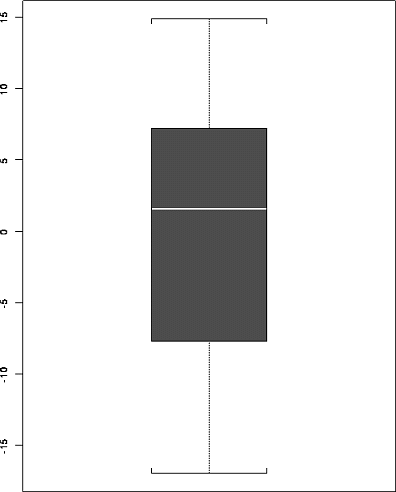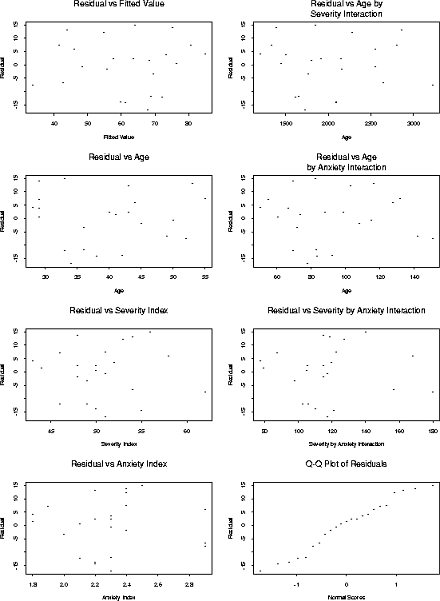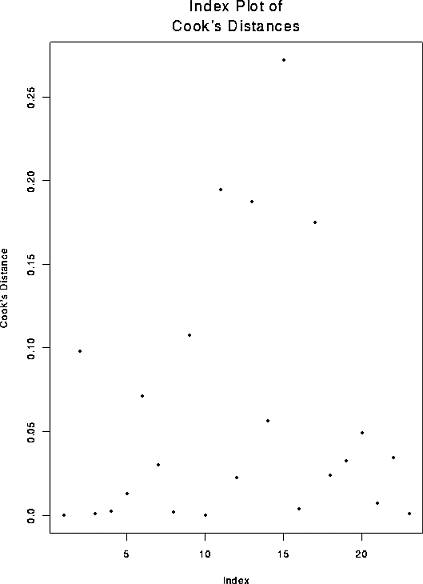STAT 350: 95-3
Assignment 4
Part A
From text page 254-255, 6.15 c, d, e, f, g, 6.16, 6.17. Page 257 6.25 and 6.26. Page 324 7.46. Page 394 9.11. Page 398 9.25.
6.15-17 I began with this SAS code:
data patsat; infile '615.dat' firstobs=2; input Satisf Age Severity Anxiety ; proc glm data=patsat; model Satisf = Age Severity Anxiety ; estimate '617a' Intercept 1 Age 35 Severity 45 Anxiety 2.2; output out=anovres r=resid p=fitted; proc print data=anovres;This code produces the anova table, t tests for individual coefficients and the estimates required for predicted values; it also prints out residuals for use later. The output shows:
6.15 c The fitted regression function is
![]()
The question asks for an interpretation of ![]() . Mathematically it means
that holding Age and Anxiety constant an increase of 1 unit in severity
of disease is associated with an average decrease of 0.666 units in
Satisfaction. The book wants you, however, to think about the real
world interpretation. Patients with more severe illnesses are less
satisfied with the hospital, after adjusting for Age and Anxiety level.
Whether the amount less is a lot or a little
depends on the units in which severity and satisfaction are measured and
since these are indices we cannot really tell.
. Mathematically it means
that holding Age and Anxiety constant an increase of 1 unit in severity
of disease is associated with an average decrease of 0.666 units in
Satisfaction. The book wants you, however, to think about the real
world interpretation. Patients with more severe illnesses are less
satisfied with the hospital, after adjusting for Age and Anxiety level.
Whether the amount less is a lot or a little
depends on the units in which severity and satisfaction are measured and
since these are indices we cannot really tell.
6.15 d Here is a box plot of the (raw) residuals from Splus; I see no problem with outliers.

6.15 e Here is a set of plots from Splus

There seems to be no particular problem in any of the 7 plots. The plots show no need for inclusion of the interactions terms and no sign of non-normality.
6.15 f You need replicate observations to compute a pure error sum of squares and you don't have any such. Sometimes people try a clustering technique to split the data set into groups of `near replicates' and then treating these groups as groups of replicates but the technique doesn't work all that well.
6.15 g You have to look in the text for this one. The test regresses
squared residuals on the covariates and computes a ![]() statistic
which looks a lot like an F test (because it was intended to be
analogous to such an F test) except for the numerator not being divided
by degrees of freedom and the denominator being somewhat different; see
page 115 and page 239. I used the code above to print out
a data set which includes the needed residuals. I saved the results
in a file, deleting all the extra output, and then ran this SAS code:
statistic
which looks a lot like an F test (because it was intended to be
analogous to such an F test) except for the numerator not being divided
by degrees of freedom and the denominator being somewhat different; see
page 115 and page 239. I used the code above to print out
a data set which includes the needed residuals. I saved the results
in a file, deleting all the extra output, and then ran this SAS code:
options pagesize=60 linesize=80; data patsatr; infile '615res.dat' firstobs=2; input Obs Satisf Age Severity Anxiety Resid Fitted; rsq=Resid**2; proc glm data=patsatr; model rsq = Age Severity Anxiety ; run;You take the Model Sum of Squares from the output which is 24518 and the Error Sum of Squares from the original output which is 2011.6 and compute
![]()
From table B 3 we see the P-value is between 0.1 and 0.9 (Splus gives a P value of 0.65) so that there is no evidence of heteroscedasticity related to the values of the covariates.
6.16 a The overall F statistic is 13.01 with a P-value of 0.0001 so the
hypothesis that ![]() is rejected at the level 0.1
and, indeed, at any level down to 0.0001. The test implies that at least
one of the three coefficients is not 0.
is rejected at the level 0.1
and, indeed, at any level down to 0.0001. The test implies that at least
one of the three coefficients is not 0.
6.16 b The text intended a joint interval using the Bonferroni procedure:
estimate plus or minus ![]() times estimated standard errors.
The estimates and estimated standard errors are in the SAS output
times estimated standard errors.
The estimates and estimated standard errors are in the SAS output
T for H0: Pr > |T| Std Error of Parameter Estimate Parameter=0 Estimate INTERCEPT 162.8758987 6.32 0.0001 25.77565190 AGE -1.2103182 -4.01 0.0007 0.30145159 SEVERITY -0.6659056 -0.81 0.4274 0.82099695 ANXIETY -8.6130315 -0.70 0.4902 12.24125126The required t critical value is 2.29; you would need to interpolate in the tables page 1337 between 0.98 and 0.985 since the lower tail area you actually want is 1-0.05/3=0.98333. Go 2/3 of the way from 2.205 to 2.346. I actually used Splus.
6.16 c From the output the value of ![]() is 0.67. We sometimes describe this as
meaning that 2/3 of the variance in patient satisfaction is accounted for
by these three covariates. This is a fairly high but not wonderful
multiple correlation.
is 0.67. We sometimes describe this as
meaning that 2/3 of the variance in patient satisfaction is accounted for
by these three covariates. This is a fairly high but not wonderful
multiple correlation.
6.17 a The output of the estimate statement is
T for H0: Pr > |T| Std Error of Parameter Estimate Parameter=0 Estimate 617a 71.6003409 16.11 0.0001 4.44322423so that the estimate is
9.11 SAS CODE
options pagesize=60 linesize=80;
data patsat;
infile '615.dat' firstobs=2;
input Satisf Age Severity Anxiety ;
proc reg data=patsat;
model Satisf = Age Severity Anxiety /XPX I;
output out=anovres r=resid p=fitted
h=hat dffits=dffits cookd=cookd
rstudent=rstudent press=press;
proc print data=anovres;
The output shows that
9.11 a The largest externally studentized
residual is for observation 14 at -1.81.
This should be compared to the value ![]() roughly. (I
used the 0.9975 column; you really want 0.9978 so my critical point is a
bit too small.) There are no surprising Y outliers.
roughly. (I
used the 0.9975 column; you really want 0.9978 so my critical point is a
bit too small.) There are no surprising Y outliers.
9.11 b The largest leverage is 0.34 (for observation 9) which should, according to the text (p 377) be compared to 2(4)/23=.35 or so. This is not too large for such a small data set but it would probably warrant a quick look at this point and at case 15 whose leverage is 0.31.
9.11 c You are supposed to compute ![]() when
when ![]() .
I printed out the entries in
.
I printed out the entries in ![]() (using the I option on the
model statement. I used S to compute the desired leverage, getting
0.87 which is an unusually large leverage; I conclude that this would
be a substantial extrapolation.
(using the I option on the
model statement. I used S to compute the desired leverage, getting
0.87 which is an unusually large leverage; I conclude that this would
be a substantial extrapolation.
9.11 d The relevant lines of output are
S R
E A S
S V N F T D
A E X I R C P U F
T R I T E O R D F
O I A I E T S O H E E I
B S G T T E I K A S N T
S F E Y Y D D D T S T S
14 51 34 51 2.3 67.9539 -16.9539 0.05661 0.07185 -18.2663 -1.80980 -0.50353
The values of DFFITS and COOKD are not too large; see
Lecture
21 for guidelines. I conclude this data point is ok.
9.11 e I did this partly in S. You need to compute all the fitted values with case 14 removed; the easiest way is to delete case 14 from the data file and rerun. You get the predicted value for case 14 by subtracting the PRESS residual for case 14 from the true Y for case 14. I got
![]()
which seems pretty minor.
9.11 f You are to plot ![]() against i. The result is
against i. The result is

6.25 You are to choose the ![]() s to minimize
s to minimize
![]()
which simply is ordinary least squares with response variable
![]()
and 3 parameters to be adjusted.
In SAS you would create a variable having ![]() and regress
it on
and regress
it on ![]() and
and ![]() .
.
6.26 The multiple correlation coefficient is
![]()
Now ![]() and
and ![]() .
If we regress
.
If we regress ![]() on
on ![]() then the correlation
coefficient is
then the correlation
coefficient is

Squaring r we see that we should prove
![]()
In lecture 4 or so I showed you that the Regression Sum of Squares is
![]()
Now

The first term is 0 because the vector of residuals is orthogonal to
the fitted vector. The last term is 0 because the sum of the residuals
is 0 in any model with an intercept. In the middle term ![]() because
because ![]() .
Hence
.
Hence
![]()
and this finishes the problem.
7.46 The reduced models are
![]()
b)
![]()
c)
![]()
d)
![]()
9.25 If X is invertible then ![]() so that
so that
![]()
The diagonal elements of the identity matrix are all 1 and ![]() so that
so that ![]() .
.
Part B
Solution: We have U=AZ where the matrix A is

Thus U has a multivariate normal distribution with mean A0=0 and
variance ![]() which may be multiplied out to give
which may be multiplied out to give

Solution: The variance covariance matrix in the previous part is block diagonal with a 2 by 2 block and a 1 by 1 block, so the first two components are independent of the last component.
Solution: ![]() . Now
. Now
![]() so
so
![]()
and
![]()
Solution: The function G is
![]()
while
![]()
Since ![]() is independent of
is independent of ![]() we see
we see ![]() is independent of
is independent of
![]() .
.
Solution: This question is wrong! You can write
![]()
as
![]()
but this is not a straightforward sum of two squares of standard normals
as written. The trick to do the real question is two write the numerator
in the sample variance for a sample of 3 as the sum of the numerator
for the sample variance of the sample ![]() of size 2 plus another
term. These two terms turn out to be independent
of size 2 plus another
term. These two terms turn out to be independent ![]() variables
except for a factor of
variables
except for a factor of ![]() .
.
Solution: The density in class was

where ![]() .
.
The entries in ![]() are c and f and we have
are c and f and we have
![]()
Then
![]()
and

Putting together all the algebra gives
![]()
where the exponent is the quadratic function

To compute ![]() we take the joint density of
we take the joint density of ![]() and
and ![]() and integrate it over the set of
and integrate it over the set of ![]() such that
such that ![]() to get
to get
![]()